The Magnificent SS France (1912): A Floating Palace of Luxury & Innovation
📌 Discover the grandeur of the SS France (1912), a marvel of early 20th-century ocean travel. Explore its lavish interiors, cutting-edge technology, and its role in transatlantic voyages. A must-read for teachers, students, genealogists, and historians fascinated by maritime history and luxury liners.
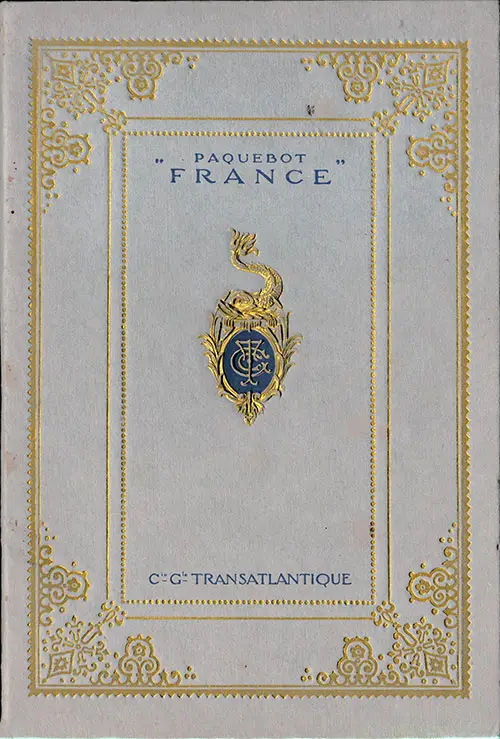
Cover, Steamship France of the Compagnie Générale Transatlantique. | GGA Image ID # 119c45b48f
The SS France (1912) – A Masterpiece of Early 20th Century Ocean Travel 🚢✨
The SS France, launched in 1912 by Compagnie Générale Transatlantique (French Line), was one of the most opulent and technologically advanced ocean liners of its time. Designed as a "floating palace," it combined unparalleled luxury, modern conveniences, and remarkable engineering innovations to ensure passengers the most comfortable and prestigious voyage across the Atlantic.
This brochure provides an in-depth look at the SS France’s first-class accommodations, dining experiences, technological advancements, and the intricate details that set it apart from its contemporaries. The article is an essential resource for maritime historians, genealogists, educators, and anyone interested in early 20th-century transatlantic travel.
For teachers, students, and researchers, this detailed account offers insights into how luxury liners reflected the social and economic conditions of their time, while genealogists can use it to better understand the experience of ancestors who traveled aboard such grand vessels.
A brochure for the Steamship SS France launch of the CGT-French Line produced in 1912 offers an excellent review of the book of first-class accommodation, services, details of the engine room and boilers, provisions, and much more. Note: This is the English translation of the French language brochure.
The New "France" Steamship of the Compagnie Générale Transatlantique. the France Liner - This New Ocean Liner Features All the Latest Enhancements, all conveniences Comforts, as well as an Unknown Luxury so Far Ensuring Passengers the Most Pleasant of Passages.
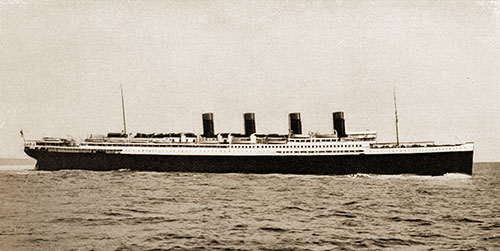
The SS "France" Ocean Liner of Compagnie Générale Transatlantique - French Line (1912). | GGA Image ID # 119c4de068
From Paris to New York
It is only seventy-five years since a regular service was instituted between France and the United States. Indeed, around 1835, the first post-service boat service was organized between Le Havre and New York, utilizing American wooden sailboats with 450 tons.
How far have we traveled since that time, so close to us, which appears to us today as remote when one contemplates the majestic ship that Compagnie Générale Transatlantique has just endowed our merchant navy.
The success of the first attempt encouraged shipowners to build larger ships. We saw so appear tall ships of up to 2,000 tons.
The English having inaugurated a service between Great Britain and the United States, a regular service was instituted between Le Havre and New York. On June 24, 1848, the port of Le Havre received the first ship of this service. He was beating the American flag.
The French Government thought that we could not abandon the monopoly of transatlantic passenger traffic to other countries. The Maritime Union offered to connect France with New York, the West Indies, and Mexico.
But, having failed to raise the necessary capital, it ceded its rights to Compagnie Générale Maritime, which was to become the Transatlantic General Company - the French Line.
The 1865 Convention states that New York ocean liners would have a speed of 11 knots.
Since that historic date, the Compagnie Générale Transatlantique has equipped its Line from Le Havre to New York with bigger and bigger ships, more comfortable, faster, and faster.
In 1864, the SS Washington was only 107 meters long, with 3,300 horsepower and 3,554 tons. The SS America, commissioned in 1873, had not increased in power, but it had raised its length to 120 meters and its tonnage to 4,636 tons.
In 1883, it was Normandy, 144 meters long, 6,500 horsepower, and 6,500 tons, and, in 1886, Brittany, 155 meters, 9,000 horsepower, and 7,315 tons.
Then came the time of the big units: in 1891, the liner La Touraine, 163 meters long, with 9.161 tons and 12.000 horsepower; in 1900, Lorraine, 177 meters long, 22,000 horsepower and 11,874 tons; in 1906, Provence, 190 meters long, 30,000 horsepower and 14,744 tons.
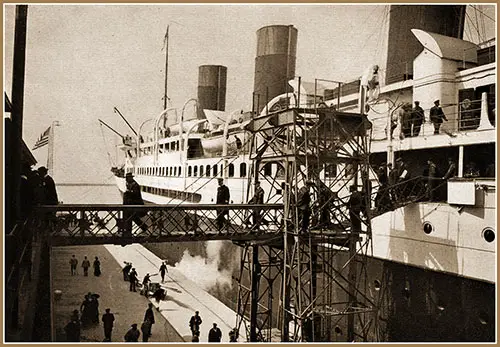
The Steamship "France" of the Compagnie Generale Transatlantique has its first departure for New York (20 April 1912). | GGA Image ID # 119c775091
Lastly, less than three years ago, the Penhoët shipyard in Saint-Nazaire was building the SS France, 220 meters, 45,000 horses, and 24,838 tons, a veritable floating city, which will carry the reputation of the SS France. The SS France steamship is a marvel, and you will judge it well if you want to visit it.
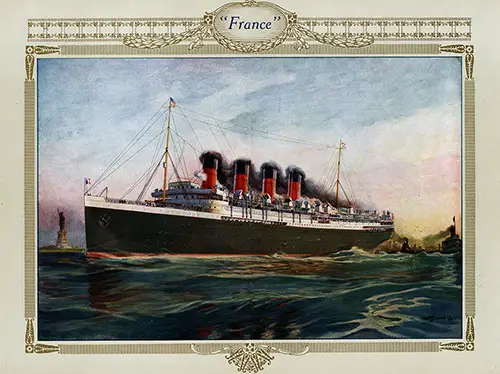
Color Painting of the SS France (1912). | GGA Image ID # 1e5de6c297
The Embarking Hall
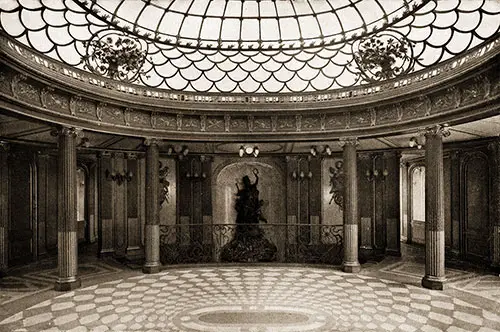
First Class Grand Hall. | GGA Image ID # 119e28f802
The transatlantic train stopped in front of the Eure basin in Le Havre. Wagons, a crowd rushes, while towards the vans hasten the doorkeepers ... A first surprise awaits the passenger.
Instead of the traditional footbridge where we hastened, we see a tent-jetty, spacious and very well installed. This innovation makes the hour of goodbye less painful.
There is no longer a gap between the immobile continent and the "working city." We seem to be taking the train for some next station. And already, before the departure, affirms the concern of the Compagnie Générale Transatlantique to assure to all its passengers complete conveniences, the desire to procure for them at the same time what we will call.
The individual comfort of the passengers is paramount for the cabin and the meals, and the General comfort, on the liner and in all places.
Individual Comfort
Enter the liner. The ship is a veritable maze, Noah's ark, where it is strongly traversed; you may ask yourself how to find your cabin in a house with a thousand floors? Don't worry. The Master of the Hotel will designate a guide who will help you avoid getting lost on the ship.
While through the bridges your guide leads you to your cabin, you will doubtlessly ask yourself this agonizing question, which harasses all those who embark on a long voyage:
"Will I have a good cabin!" There is no need today to worry.
All cabins are good aboard the "France."
You will be able to judge.
First Class on the SS France
The cabin. The liner "France" contains 207 cabins of first-class and 51 cabins of mixed first, divided between the bridges (73), main (109), and higher (25 and 51 mixed). The particular originality of these cabins consists in the composition of the partitions.
The passenger will find in his cabin the charm of his home. Wood has been substituted, in most cases, the fiber-cement. It was used the least possible paint so that no smell emerges from these apartments - advantage of the most palpable.
More of these superimposed and classic berths! Cozy copper beds have replaced them.
Many cabins have two beds, others a single, while some, about forty, have a sofa bed.
The various cabins of the bridge promenade and the main bridge are decorated in the modern taste. Their ornamentation includes pretty Irises evoking country subjects and woods of new essence.
Compagnie Générale Transatlantique has completed these sumptuous installations by adding, to most cabins, a water closet, and a private bathroom.
Many of these cabins are also equipped with a toilet. It should be noted that these facilities do not exist on the largest cruise ships recently built.
Finally, an electric clock will allow everyone to measure, at any time, the elapsed time.
Luxury Suites
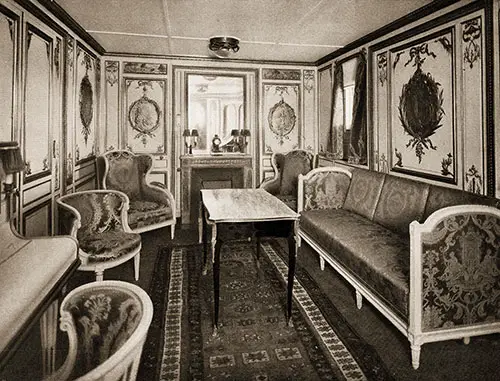
Living Room of the Luxury Suite. | GGA Image ID # 119c792ea9
Do not forget that the New York route is frequented by high society. The Compagnie Générale Transatlantique wanted to do even better. She had four luxury apartments and a luxury apartment, which no liner could offer the equivalent.
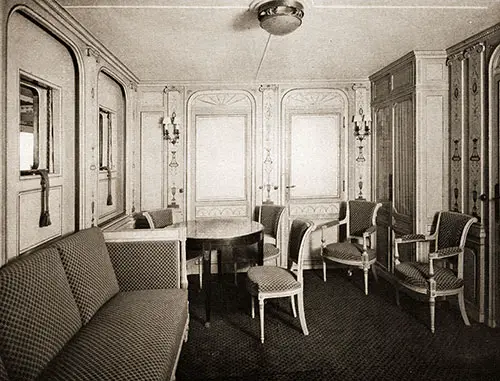
Private living room of a Luxury Suite. GGA Image ID # 119cb54ee5
The luxury apartment extends over more than twenty meters to starboard, under the combined living room and the tent-bridge gallery.
It is entered by an antechamber, which gives the bathroom and the toilet. Here, clear and cheerful, the Directoire room, a vast Louis XVI salon, which would not deter one of our castles of Touraine.
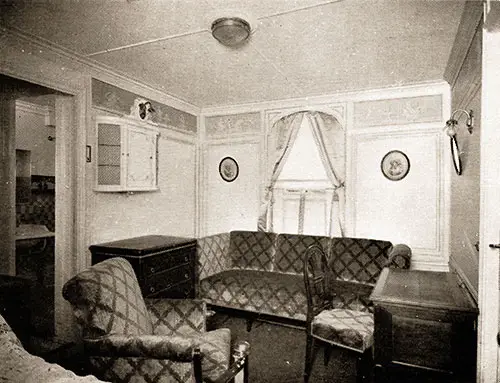
Luxury Cabin. | GGA Image ID # 119cd5ef5c
A corridor on which opens the office connects the living room to the dining room with ashlar burrs, in the purest style of the Empire; finally, at the end of the house, cozy and intimate, a Louis XVI room invites you to a peaceful rest. This room comes with a bathroom and a toilet.
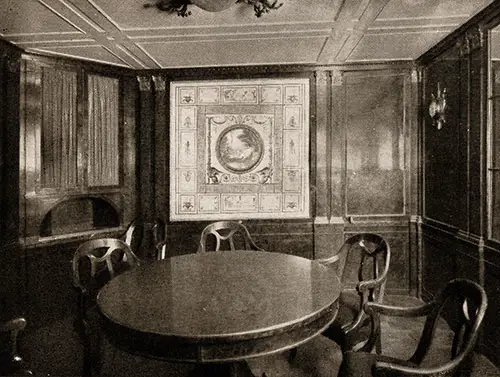
Dining Room of the Luxury Suite. | GGA Image ID # 119ca47bb9
The luxury apartment can accommodate six people. It contains, in fact, a double bed, a single bed, and three sofa beds. There is no doubt that all the kings of the American industry will fight for the honor of occupying this princely residence where art combines with the most refined comfort.
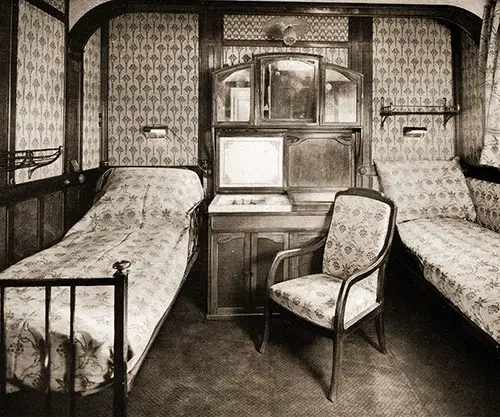
First Class Cabin. | GGA Image ID # 119ce48276
Opposite this apartment, on the port side, two luxury apartments, less affluent but no less pleasant, include one Louis XVl room with a Directoire lounge, the other a Louis XVl room with a Louis XV lounge; it is a very aristocratic dwelling, and one will feel much more at home than in the most important hotels.
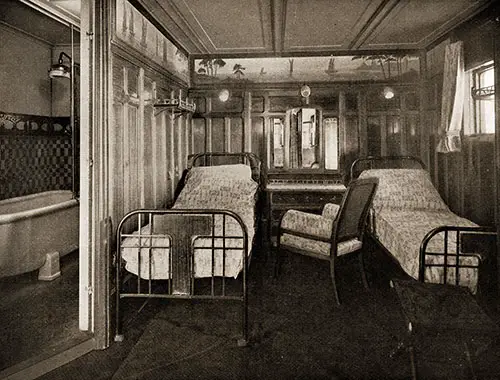
First Class Cabin with Baths. | GGA Image ID # 119cd77d20
Both have bathrooms, toilets, wardrobes, all the details of modern living that make them so attractive to us, and dumbwaiters provide communication with the lower offices.
At the front of the bridge promenade, two other apartments, decorated but of less importance, were arranged.
Dining Rooms
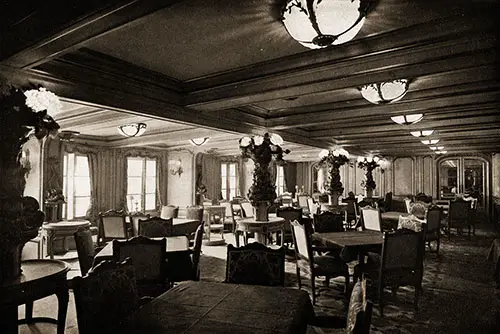
Corner of the First Class Dining Room. | GGA Image ID # 11a1c9072e
We love the vast dining rooms. It seems that the exiguity of the premises must hinder digestion. A low ceiling does not encourage appetite.
The first-class guests of "France" will not experience this sensation. The Compagnie Générale Transatlantique gave them a real surprise. Imagine a large hall occupying three entrees of the ship and measuring eight meters in total height.
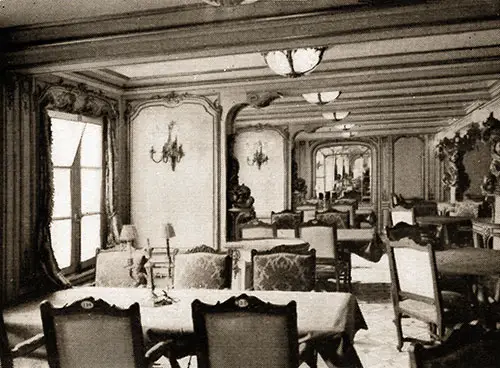
A Corner of the First Class Dining Room. | GGA Image ID # 119f859484
This hall itself is divided into two floors. Three hundred fifty passengers can take place at mealtimes.
In the center of the hall stands a dome, supported by pilasters. A magnificent staircase ensures the connection between the two levels. The French Line borrowed the decorations from the former hotel of the Count of Toulouse, owned by Robert Decotte, son-in-law of Mansard, the famous architect of the Louvre.
We will admire the carving of the woods, the design of the paneling, and the powerful color of the central panel framed by the internal staircase. With warm, luminous tones, this work represents the French Grace and bears the signature of the eminent painter La Touche.
The same artist has painted the cupola ceiling, which evokes, with as much charm as poetry, the great regions of France.
Breaking with the tradition of large tables, dear to old ships, the Company has adopted the fashion of small tables, more family, more intimate, and where one can isolate oneself in the middle of the community.
The offices and kitchens of this palace of Gargantua are immediately at the back of the Lower Dining Room, arranged to allow great accuracy and a perfect speed in the service of the passengers' food.
The Monte Plats. For the sick and the service of morning breakfasts, a particular office has been established at each bridge, communicating utilizing hoists and telephones with one of the principal offices. This practice will not fail to be highly appreciated by passengers.
Finally, the French Line installed an American-style bar on the main deck for those quickly altering the sea air.
The Tent-Bridge Exhibitions
Over a length of about 150 meters, the tent bridge is occupied by an extended suite of lounges, of which one can say, without fear of being denied, that they recall the rooms of a royal palace than the standard layouts of a liner.
Compagnie Générale Transatlantique wanted it to be challenging to do better. Perhaps one could accumulate more gilding, motifs, and furniture; it would be impossible to compose the most sumptuous installations with more art and skill.
The Central Staircase
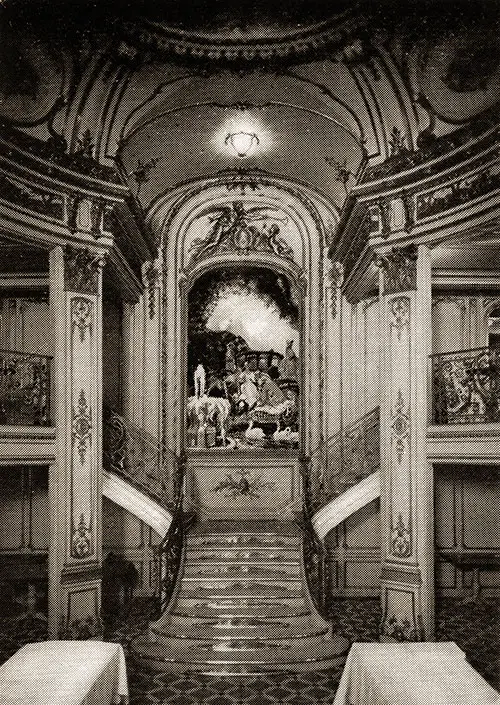
Grand Staircase of the First Class Dining Room. | GGA Image ID # 119dadec5a
It is the thought that comes to mind when one examines the decorative set formed by the upper tier of the Great Staircase. We find ourselves, in fact, in the middle of an arcade, supporting an oval dome in finely wrought ironwork.
Green marble panels and ironwork doors surround the colonnade. Four high reliefs in mercury-gilt bronze enhance the walls of the dome. Baskets of electric flowers pour their light into the room.
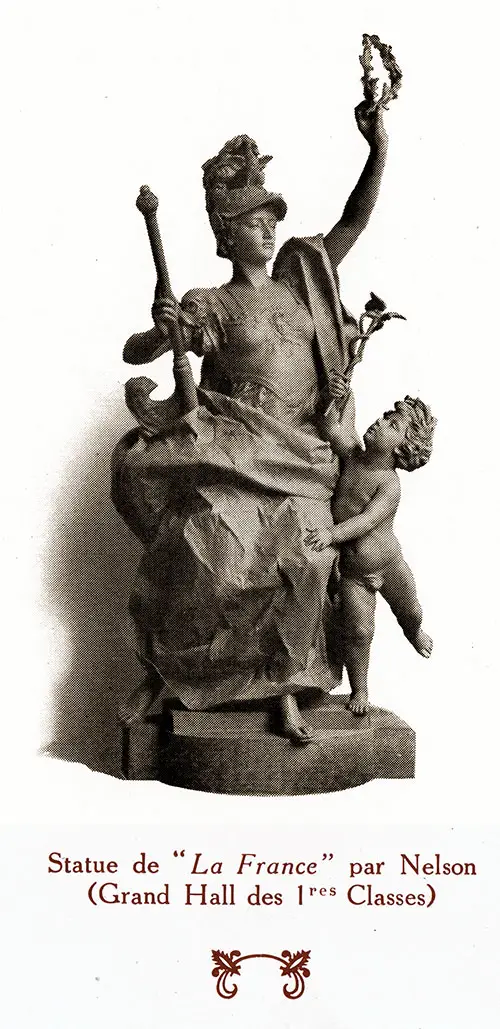
Statue of "France" by Nelson - First Class Great Hall. | GGA Image ID # 11a22ddb37
A wrought iron railing surrounds the stairs leading to the lower floors. A bronze statue of "France" is inscribed in a niche in the stairwell, on a base veined with red. The work of the sculptor Nelson has an excellent pace and still contributes to the beauty of this monumental staircase.
Salon de Conversation
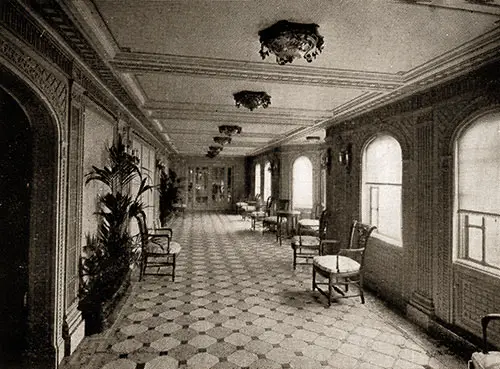
A First Class Gallery. | GGA Image ID # 11a09a9876
Forward, two galleries lead to the chat room, one of the most elegant that can conceive. In the background, a magnificent mantelpiece is surmounted by the portrait of Louis XIV by Hyacinthe Rigaud, a copy of a striking truth, according to the painting preserved in the Louvre.
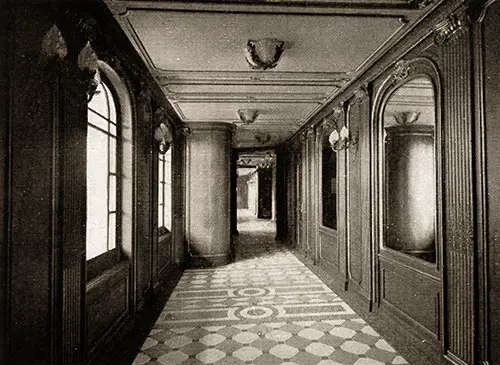
First Class Gallery. | GGA Image ID # 119edbc519
There are four beautiful portraits on the ribs of the canvas: the Princess of the Tower-du-Pine, Madame de Maintenon, Henriette of England, and the Duchess of Burgundy. The century of the Great King could not be better evoked.
Opposite Louis XIV of Rigaud, a large painting after Van der Meulen (Museum of Versailles), represents Louis XIV returning from a hunting party in the gardens of Versailles.
Opulent armchairs and elegant, stylish shepherdesses are arranged for the wonder of the eyes and the conveniences of conversation. Here are seats covered with tapestries Aubusson, there we see velvets of Genoa jardiniere, again, damask purple.
In front of the fireplace, notice this seat in X borrowed furniture Versailles. All this furniture stands out firmly on the blue carpet of king, which stifles the sound of footsteps.
Do not forget to raise your head to contemplate the central dome, so graceful, and the delicate frescoes of Boucher (Fontainebleau museum), the Dawn, and the Twilight.
The Library
Silently and collected, the library of the purest Regency style opens at the back and to the right, whose walls disappear under the carved wooden paneling. This secluded place will be much appreciated by those who like to think in the company of our friends, the books.
Typing
Those who have no time to wander or to meditate, who have copies to be executed, will find, on the left, in a small office, the typist, whose good offices will often be demanded.
The Mixed Use Lounge
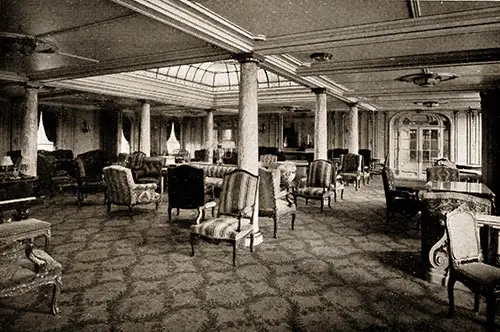
First Class Mixed Use Lounge. | GGA Image ID # 119d6db5f2
Let's go back on our steps towards the Great Staircase. The eye rests on painted green and gold wooden paneling and pink marble columns. Two galleries with clarity allow access to the combined lounge, Regence style.
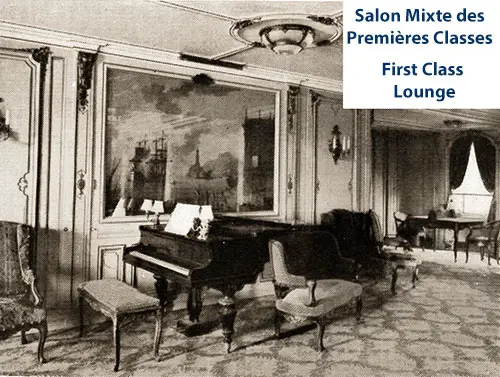
First Class Mixed Use Lounge. | GGA Image ID # 119fd69a80
To the right and the left, please do not fail to examine, with all the interest they entail, four magnificent tapestries of the Savonnerie of considerable value; they represent marine subjects. On the chimney and above a console, the two canvases that you see are authentic at both ends of the room.
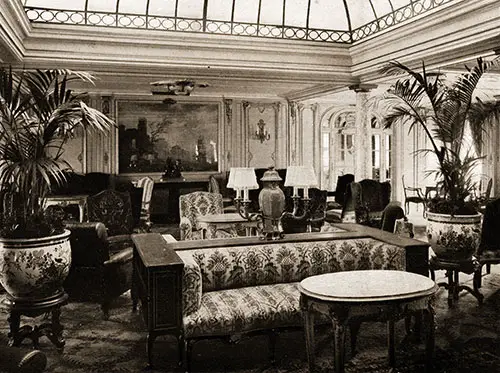
Mixed Use Lounge of the First Class. | GGA Image ID # 11a07d1293
These views of Italian landscapes date from 1774 and bear the signature of the painter Lacroix. The ship's designers installed a quadruple sofa with table H in the living room center.
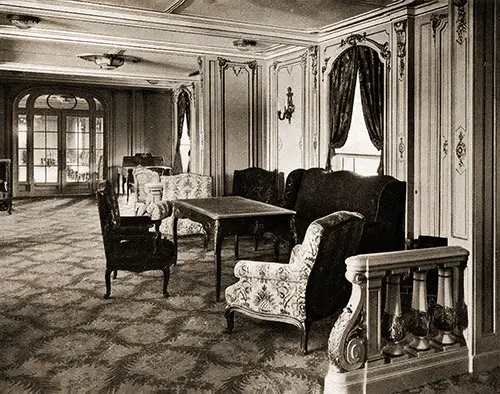
A Corner of the First Class Mixed Use Lounge. | GGA Image ID # 11a0833d61
A grand piano, play, and writing tables complete the furnishings of this hall, where the sun comes in complete rays. The armchairs are upholstered in leather or velvet. Let's cross-communication galleries in the Louis XVl Trianon style, as fresh as gardens.
Moorish Lounge
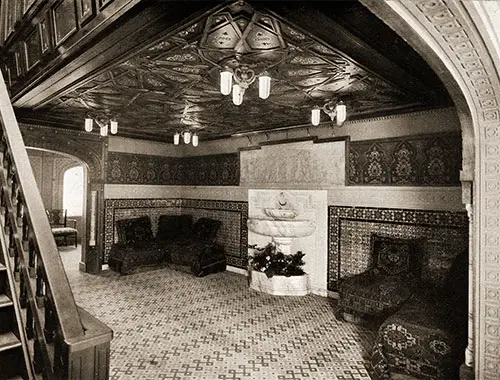
Moorish Lounge. | GGA Image ID # 119ea683db
A stop is needed at the delicious Moorish lounge, where smokers can come to drink. To this end, the Compagnie Générale Transatlantique's foresight has created a marble fountain that springs icy water.
The walls of this building are covered with mosaics, ornate with arabesques and wooden panels. Above the source, which flows into a double basin, hangs a fresco, Algeria, by the orientalist artist Poisson. This sculpture, which appeared in the salon, and was highly praised, has a lot of character and life.
Smoker and Terrace
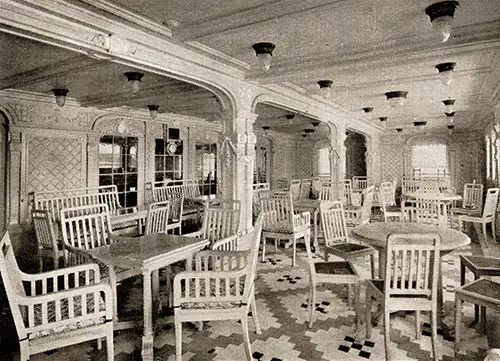
Café Terrace. | GGA Image ID # 119f547509
Continuing towards the back, we will reach the smoking room, which presides Colbert, whose portrait embellishes the veined marble fireplace.
This room, of large dimensions, is, like the mixed living room, Regency style, with carved wood paneling. Armchairs, and velvet green water, throw a clear and joyful note. Ice and strong waters harmonize on the walls.
This room communicates directly with a terrace, turned towards the ship's rear. Large windows, which can be closed utilizing thick and mobile windows, let one's gaze wander over immensity.
A trellis of soft green in two shades decorates the partition. You can smoke like in the open air in good weather, and if bad weather rages, you can brave it, sheltered from the strongly rectified ice.
The Lifts
To the right and left of the Grande Staircase stairs, one can see very artistically ironed grids. These gates close the cage of the two elevators that serve the various floors of this gigantic ship.
Children's Rooms
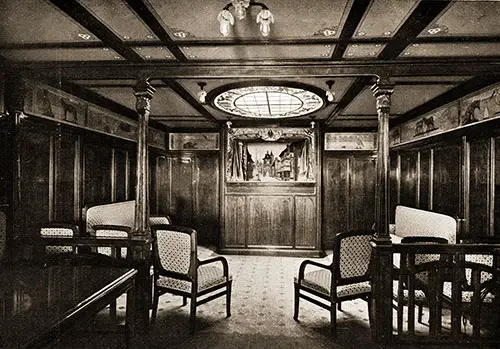
Children's Games Room. | GGA Image ID # 119d5fd284
Children have not been forgotten by the Compagnie Générale Transatlantique, the most maternal of all. On the one hand, it was necessary to prevent the passengers from being embarrassed by the cries or the strokes of the children, and on the other hand, that they could occupy their leisure without too much trouble.
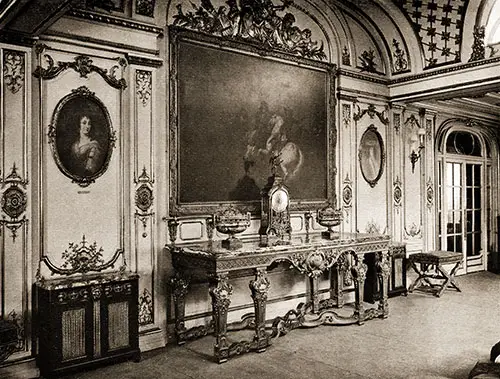
Grand Salon of the First Class. | GGA Image ID # 119e6283d6
Two rooms are reserved for the turbulent youth. At the bridge of the boats, at the end of the large living room, and completely isolated from the latter, has been arranged a playroom, where Guignol will give daily performances. This piece will certainly not be the least joyful of the ship.
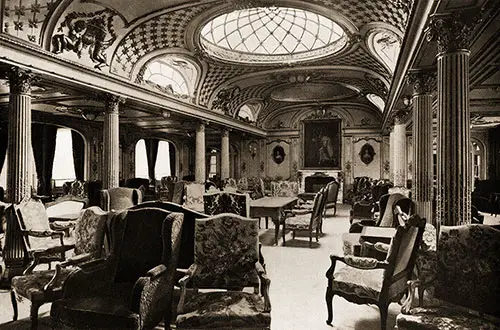
First Class Grand Salon. | GGA Image ID # 11a0ad5f29
At the upper dining room level was installed a childish dining room. Paintings under glass include the stories dear to our young years, the blue tales, and the golden legends. Little Red Riding Hood is there with Ali-Baba, and we see Mr. Lustucru doing a lousy job at Mother Michel's cat.
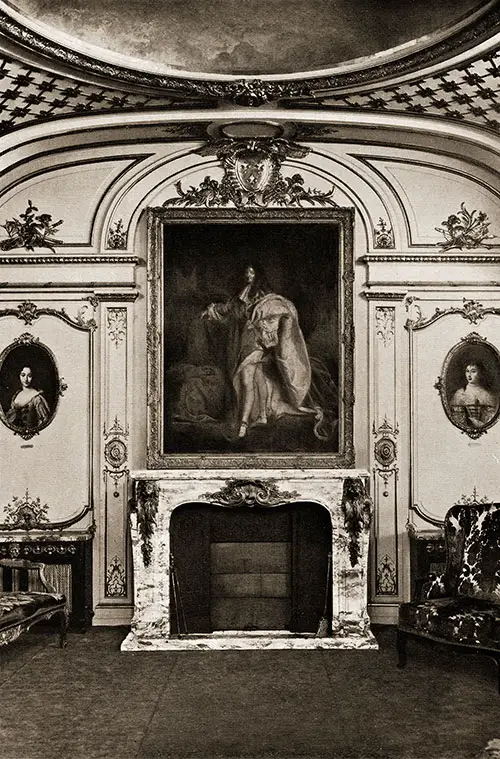
Fireplace of the First Class Grand Salon. | GGA Image ID # 11a0bee5b3
Hairdressing Salons
The life of big ships is essentially worldly, especially in the evening. Ladies and gentlemen often need the help of a hairdresser. Two very modern hairdressing salons have been set up. All furnishings are mahogany.
Second Class
To describe the arrangements of the second class, it would be necessary to start again to study the different premises in which life flows in cabins or the life in the apartments.
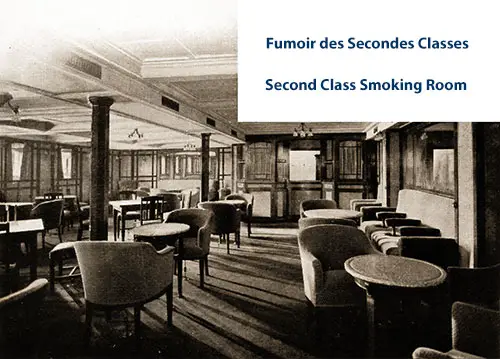
Second Class Smoking Room. | GGA Image ID # 119dff436a
We will call them a single word, which everyone will understand: the wealth and comfort of the second class in the SS France correspond to the wealth and comfort of the first classes on the old ships.
The dining room, large and cheerful, is at the steerage.
It is connected by a beautiful staircase whose levels are decorated in the Regence style. The lounge and the smokehouse are placed at the back of the ship, on the main deck.
The living room is a half-tone. The background is in the range of blue and gold, and the furniture is green-water. The seats of the smokehouse, of gray velvet, harmonize nicely with lemon-colored panels. All the decoration was elegant.
The cabins are much more spacious than the second class of the other liners. The bathrooms have been multiplied on all floors.
Finally, a unique hairdressing salon is located near the second-class information desk on the upper deck.
Third Class
Finally, the third class passengers also have common premises, exceptionally spacious dining rooms, a smokehouse, and a refreshment bar. This class of passengers has its particular food service with its galleys and its kitchen, entirely separated from the benefit of the first and second classes.
General Comfort

Collage of First Class Accommodation of the Steamship France (1912). From top to bottom: First Class Library; Grand Salon of the First Class; Mixed Use Lounge of the First Class; and First Class Smoking Room. | GGA Image ID # 119f72efb7
With the refinements of the contemporary era, we are accustomed to finding in all places the same facilities that we encounter at home. The Compagnie Générale Transatlantique did not want it to be otherwise on "France," It strove to make the passengers stay as comfortable as possible.
The Orchestra
Several times a day, an orchestra, recruited with care, makes the passengers listen to the most classical music as the most fashionable. In the evening, balls allow tasting the pleasure of the dance.
The Promenade Bridge
For those who like to contemplate the horizon, breathe the fresh air, probe the immensity, or immerse their eyes in the constellated sky, we have built on the "France," a vast bridge-walk sheltered against the high winds by movable windows.
On stormy days, passengers will be allowed to stay on this deck, limberly stretched out in a comfortable rocking chair.
The Inventory of the Florist
A florist stall was installed on the promenade deck. It is expected that it will be bustling. There will also be trinkets and postcards, and we can imagine that we have not left the mainland.
Mechanotherapy
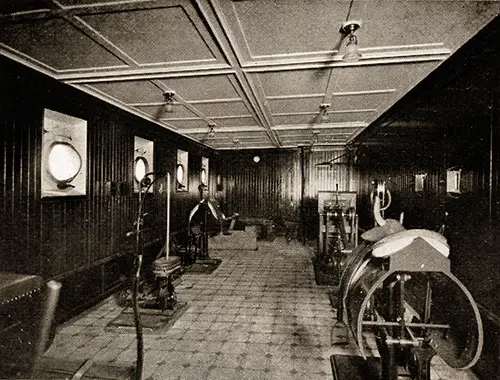
Mechanotherapy. | GGA Image ID # 119f14bc01
Some people, accustomed to a very active life, sometimes complain of the impossibility on board the ships to maintain their muscle condition. Others, by diets, must use their nerves.
For the use of each other, a mechanotherapy room has been established in front of the tent bridge. The installation has a Seistès vibrator, extensors for the arms, and a rowing machine. It can be done mechanically, horse, bicycle, or even camel.
Hydrotherapy
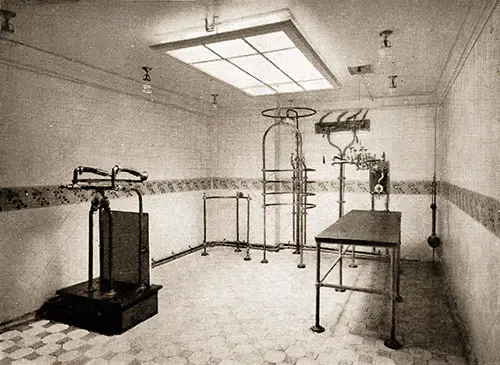
Hydrotherapy. | GGA Image ID # 119f712337
Next to the mechanotherapy room, the Hydrotherapy Room is equipped with the most modern fittings: showers in a circle, jet, rain, underwater massage, and adjacent to the massage room that a specialist serves, and to the restroom.
Games
On the other hand, various games are made available to the passengers, who can recreate themselves at ease; croquet, barrel play, and shuffle-board game make it possible to brief the crossings.
Wireless Telegraphy
Finally, the liner hand permanently, its communications with the land, thanks to wireless telegraphy. An innovation, which will be very popular, is worth mentioning: a waiting room, very spacious, has been installed for passengers who have messages to ship.
Information office
An information desk has been set up in the lobby of the grand staircase on the main deck floor. The public will find all the indications he may wish.
A safe-deposit box, similar to the ones that the Financial Institutions Dining Room puts at the disposal of their clientele, is attached to this office.
Onboard Newspaper
A printing works on "France" for the draw of menus, and the publication of the Journal de l'Atlantique appears the latest news received by wireless telegraphy "France" is a modern city with all the organs of which we do not would no longer be able to dispense.
The Vessel
To animate a colossus like SS "France," to operate its multiple organisms, to ensure its rhythmic pulsations, a small army is needed, to which the command gives the impulse and of which it maintains the homogeneity.
The captain is assisted by a second captain, four lieutenants, a pilot, two doctors, and three commissioners.
The Size of the Giant Ship
"France" is a giant. Its length is 217 m. 63, its width of 23 meters, and its height of 21 m. 50 from the keel to the bridge where the boats are. Initially, the ship's draft was nine m. 10, and its displacement to this draft reached 27,190 tons.
Under the final bridge is a freight tale. The liner has eight decks, seven of which have a passenger or officer accommodations. The last deck is reserved for passenger baggage, food onboard, and goods.
The total number of persons on board is 2,558: 535 first-class passengers, 442 second-class passengers, 950 third-class passengers, and 631 crew members for passenger services.
The Brain
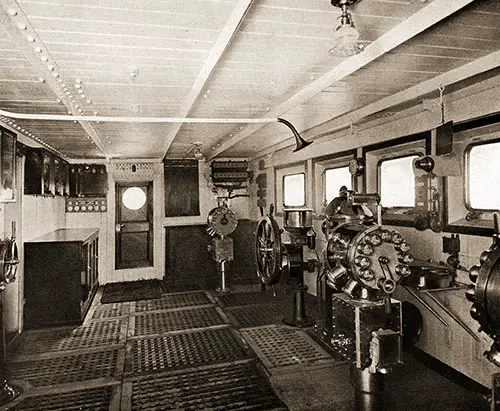
The wheelhouse. | GGA Image ID # 11a0f7402a
The bridge of the commander is the brain of this colossal body. Here are the machinery control devices, the rudder, the various machinery of the bridge, front and rear; others maneuver whistles. From there, leave all the nerves that involve the active organs of the ship.
Still, others provide for passenger safety. At the time of any danger, the commander may, at his discretion, close all the doors leading to the watertight bulkheads.
The devices are very different: mechanical, electrical, and hydraulic. The gateway also has loudspeaker phones and optical signal devices.
A special indicator makes it possible to ensure the proper functioning of the navigation lights; a central clock sends the time in the lounges and cabins.
The chart room has its nautical library, chronometers, and sextants. Finally, a room of silence allows the audition of the underwater bells for the days of fog. We are amazed that so much can hold in so little space.
Lungs and Heart
Nothing is more curious and instructive than a visit to the "lungs" and the "heart" of the colossus. Four propellers power the liner "France." Its evaporator consists of eleven boilers, eight fireplaces each, eight boilers with four fireplaces, or 120 fireplaces with a grid area of 222 square meters.
Coal consumption for a 140-hour crossing is about 4,000 tons. The consumption of freshwater must reach nearly 800 tons. The power thus obtained is 45,000 horsepower, and steam production per hour of 270,000 kilos.
To avoid the need to carry more than a thousand tons of freshwater for the supply of boilers, the ship is equipped with evaporator boilers in which the seawater is distilled.
The machines demand not only coal and water but also air. This air is supplied by sixteen electric fans, with a total flow of 530,000 cubic meters per hour.
This quantity of air weighs about 690 tons and corresponds to twenty-three times the weight of the coal. The fan flow maintained during the 140 hours of crossing corresponds to a total air weight of 96,500 tons.
The air is sucked by large wells located around the chimneys in eight ventilation chambers placed above the boilers. It is repressed in heaters, which bring its temperature to 300 degrees, and finally sent on the grids.
If necessary, these ventilators could be used for aeration of the vessel.
In this case, they would be likely to renew the total air volume, including holds and holds, ten times per hour, which corresponds to twenty times per hour for inhabited premises.
The engine unit consists of four turbines, each placed on a line of trees: a high-pressure turbine, a medium, and two low pressure. In addition, there are two high-pressure turbines and two low-pressure turbines for reversing.
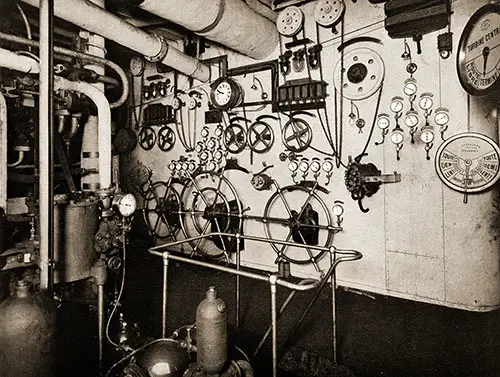
Turbine Maneuvering Table (Control Room). | GGA Image ID # 11a17f0d11
The turbines comprise 618,300 copper fins, of which 290,700 are fixed, and 327,600 are mobile. These fins placed end to end would represent a ribbon of 109 kilometers.
This figure provides an idea of the considerable adjustment work involved in building this power device.
For the first time, on the SS "France," we use a turbine engine with triple expansion.
To give an idea of the power of the turbines of "France," we will observe that the inside diameter of the pipe, which combines the average at low pressure, is nearly two meters (1m 930).
Thanks to a very clever device, the ship being a freeway, it is possible, by a single maneuver, to put the four propellers in reverse at a time to avoid an impending collision.
The entire engine unit is placed in two compartments, and the crew could invade one of these compartments. Without that, the rest of the engine is paralyzed. We would be satisfied with only walking with two propellers.
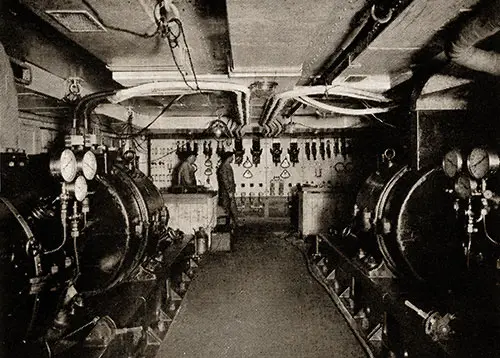
Group of Dynamos. | GGA Image ID # 11a1105ee9
The edge's lighting and driving force are provided by two electrical stations, each including two turbo-dynamos of 400 horsepower.
The RMS "France" offers this particularity of not having a water tower. The pumps pump the cold or hot water into tanks filled with compressed air at the top, from where they are returned under pressure.
For hot water service, there is a continuous flow of piping, with a return to the starting point, to prevent the cooling of the water before its use by the passengers.
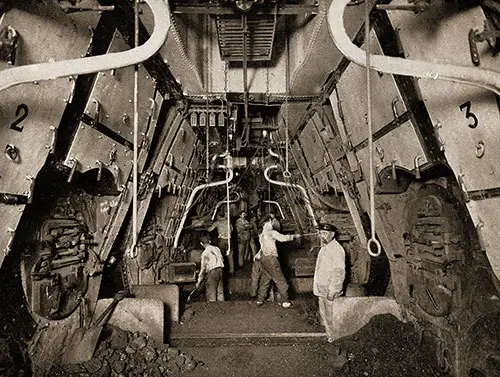
Stokers Keep The Coal Fires Buring in the Boiler Room. | GGA Image ID # 11a1519802
Finally, let us add that for the simplification of the boiler room service, the coal is distributed around the four groups of boilers, and that, to allow the general service of the boiler rooms, the machines, and the edge, it has been arranged, in the last twenties, a wide corridor that connects the various compartments.
There is, therefore, no need to open the doors at the bottom of the fifteen bulkheads that divide the ship into sixteen watertight compartments.
This extensive service corridor contains the auxiliary equipment needed to service the machines, the ship's life, and the ship's safety.
At the rear, it is located in the supply stores and the stations reserved for the drivers and the civilian personnel of the crew, and in front, in the deck crew positions and some of the emigrants.
the "Bell" of the Monster
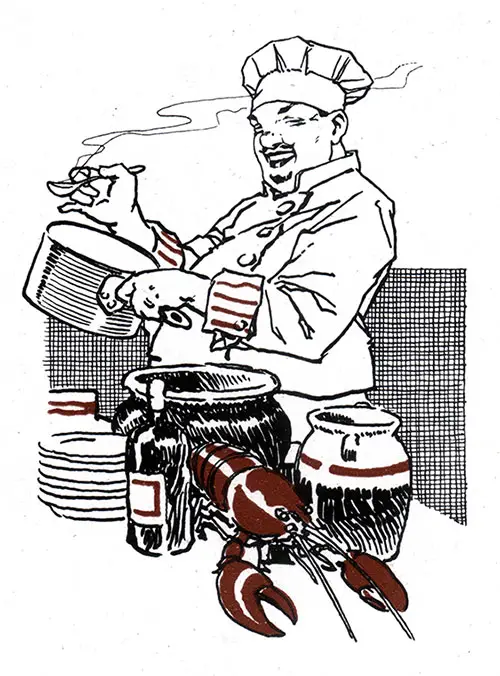
The Chef of the Ocean Liner France. | GGA Image ID # 11a25cb5a2
Table Supplies.
A monster such as the ship "France" engulfs prodigious quantities of food, especially since the vessels of the Compagnie Générale Transatlantique are renowned for the quality of their table.
From Le Havre, the liner carries:
- 9,000 pounds of fresh meat,
- 22 whole oxen,
- 13 sheep,
- 8 calves,
- 4 pores,
- 350 kidneys,
- 270 beef tongues,
- 550 squares of chops,
- 400 legs,
- 80 heads of veal,
- 400 feet of veal
- 29,000 kilos of cold meat, poultry and game, distributed as follows:
- 750 kilos of various pork meats,
- 500 feet of pork,
- 75 ham,
- 18 barrels of foie gras,
- 800 chickens,
- 700 pigeons,
- 180 rabbits,
- 400 ducks,
- 70 turkeys,
- 50 geese,
- 1,100 quail,
- 550 partridges,
- 250 grouses
- 70 pheasants.
The fish shop is stocked with 4,500 kilos of various fish, 40 kilos of shrimp, 250 lobsters or lobsters, and gourmets have at their disposal 600 dozen oysters.
To these figures, let us add:
- 15,000 kilos of potatoes,
- 900 of carrots,
- 750 of onions,
- 750 of turnips,
- 700 of cauliflowers,
- 900 artichokes,
- 750 cabbages,
- 400 leeks,
- 700 radishes,
- 5,900 salads,
- 6,000 kilos of dried vegetables,
- 3,700 of pasta,
- 16,000 kilos of flour for the bakery,
- 35,000 eggs,
- 3,000 pounds of butter,
- 5,400 cans,
- 1,500 kilos of cheese,
- 9,000 oranges,
- 6,000 pears,
- 6,000 apples,
- 380 jars of jam,
- 100 jars of honey,
- 110 kilos of dragees and pralines,
- 75 boxes of marmalades,
- candied fruits,
- cakes, etc., in abundance.
For the drink, it is planned
- 300 kilos of tea,
- 500 of chocolate,
- 150 of coffee,
- 6,000 liters of fresh milk,
- 6,000 kilos of sugar.
Wine Cellars. The cellars of the liner "France" do not yield in any way to those of the most famous restaurants. There are: 60,000 bottles, including
- 2,300 bottles of champagne, and
- 2,000 half-bottles,
- 1,800 bottles of fine wines,
- 350 liqueur wines,
- 2,500 bottles of beer,
- 900 of liqueurs,
- 2,800 of mineral waters and
- 2,500 half-bottles,
- 1,500 bottles of lemonade,
- 25,000 of ordinary wine and
- 30,000 liters for the crew.
Laundry. No housewife has ever had a supply of linen similar to that of the liner "France", which includes
- 7,200 sheets,
- 3,800 pillowcases,
- 1,200 tablecloths,
- 20,000 napkins,
- 22,000 toilet,
- 8,000 tea towels,
- 2,500 aprons and
- 2,000 washbasin towels.
The Dishes. Finally, as it is appropriate that the container responds to the content, the dishes are porcelain style Louis XI V and silverware Louis XV style.
And now, all you have left is to embark. The colossus ship is waiting for you.
A. PAWLOWSKI.
DRAEGER, IMP PARIS
Brochure Information
- Date of Publication: 1912
- Publisher Draeger, Paris, France
- Pages: 36
- Cover: Hardcover - No Dustjacket
- Binding: String
- Dimensions: 15,3 cm x 22,5
- Language: French
- Description:
The Compagnie Générale Transatlantique issued this beautiful brochure to present its luxurious new ocean liner, the FRANCE.
This rare original brochure dates from 1912 and features a gold embossed cover with an early "CGT" (French Line) monogram in a blue medallion surrounded by gold embossed dolphin and rinceaux cartouche, in the style of the 18th-century decor used in the ship. The cover borders and inside flaps and the borders and illustrations used in the page layout are a more modern Art Nouveau style.
The interior of the brochure is comprised of 16 pages of text in French by A. Pawlowski, illustrations, and photographs presenting the ship, including rare images of the legendary "Appartement de grand luxe" with its giltwood paneling copied faithfully from the private royal apartments at Versailles, the magnificent "Grand Hall" (the paneling of which is now displayed at the French Line museum in Le Havre) and the sumptuous "Grand Salon" with its copy of the Rigaud portrait of Louis XIV.
The center of the brochure holds a handsome two-page color artist's impression of the FRANCE in New York harbor.
The last two pages are dedicated to the "Ventre du Monstre," the "Monster's Stomach," and extolling the many virtues of Compagnie Générale Transatlantiques cuisine, listing the incredible quantities of beef, fish, wine, etc. brought on board for every voyage.
This first brochure emphasizes style and cuisine over safety, although a section on the ship's engine room mentions the watertight door and compartment system. It is interesting to note that the FRANCE's maiden voyage took place on April 20th, 1912, just five days after the sinking of the TITANIC. The French vessel had a sufficient number of lifeboats for the 2,558 souls on board right from the start and did not have to be altered due to the TITANIC disaster.
Who Should Read This & Why?
📚 Teachers & Students
✅ Ideal for lessons on early 20th-century transportation, globalization, and luxury travel
✅ Demonstrates how advancements in shipbuilding shaped modern travel
✅ Explores class distinctions in ocean travel before the First World War
🏡 Genealogists & Family Historians
✅ Provides context on what ancestors might have experienced while traveling aboard ocean liners
✅ Explains how passenger accommodations reflected wealth and social status
✅ Details the high standards of French cuisine and hospitality aboard transatlantic ships
⚓ Maritime Historians & Ocean Travel Enthusiasts
✅ Examines one of the most prestigious ships of the pre-WWI era
✅ Explores the impact of the Titanic disaster on ship design and safety
✅ Showcases the role of France in transatlantic luxury travel
Most Fascinating Aspects of the SS France (1912) 🚢✨
1. A New Era in Transatlantic Travel: The Evolution of Ocean Liners 🌍⚓
🔹 The SS France was the culmination of decades of advancements in shipbuilding.
🔹 Since the first French-American mail service in 1835, transatlantic travel had transformed from small wooden sailing ships to massive steel steamers.
🔹 By 1912, France had established itself as a leading force in the luxury liner market, competing with British, German, and American companies.
💡 Why It’s Interesting: The SS France symbolized France’s ambition to dominate the luxury travel industry, blending technological progress with artistic grandeur.
2. The First-Class Experience: Unparalleled Luxury & Comfort 🏰✨
🔹 The first-class section of the SS France was designed to rival the best European palaces.
🔹 207 cabins, including lavish luxury suites, provided private bathrooms, fireplaces, and custom furniture.
🔹 Public spaces, such as the Grand Hall, Drawing Room, and Moorish Lounge, reflected Louis XVI, Directoire, and Regency styles.
🔹 Noteworthy images:
📸 First-Class Grand Hall: An opulent entrance with wrought-iron detailing, marble floors, and a bronze statue of "France."
📸 Luxury Suite Dining Room: Modeled after the grand salons of Versailles, featuring intricate wood paneling and period furniture.
💡 Why It’s Interesting: The SS France’s interiors blended historical elegance with modern amenities, ensuring passengers traveled in the utmost luxury and comfort.
3. A Gastronomic Masterpiece: The Finest Dining at Sea 🍷🍽️
🔹 The first-class dining room was an architectural marvel, spanning two levels with an eight-meter-high dome.
🔹 Decorated with art by famous painters, it could accommodate 350 guests at a time.
🔹 The ship carried extraordinary quantities of fresh meat, seafood, produce, and fine wines:
- 9,000 pounds of fresh meat 🥩
- 4,500 kilos of fish 🐟
- 6,000 liters of milk 🥛
- 60,000 bottles of wine & champagne 🍷🍾
💡 Why It’s Interesting: The emphasis on gourmet dining showcased French culinary excellence, making every meal aboard the SS France an extraordinary experience.
4. The Engineering Marvel: Power, Safety & Innovation 🔥⚙️
🔹 Four massive turbines produced 45,000 horsepower, propelling the SS France across the Atlantic at impressive speeds.
🔹 The ship’s innovative safety features included watertight compartments and reinforced bulkheads, ensuring greater stability and security for passengers.
🔹 Two turbo-dynamos powered the ship’s electrical systems, allowing for electric lights, mechanized laundry facilities, and advanced communication systems.
🔹 Noteworthy images:
📸 Turbine Maneuvering Table (Control Room): Showcases the ship’s advanced navigation and propulsion systems.
📸 The Boiler Room: Highlights the massive furnaces that powered the SS France’s transatlantic crossings.
💡 Why It’s Interesting: The SS France was a technical masterpiece, incorporating some of the most advanced maritime engineering of the early 20th century.
5. A Ship Built for High Society: Entertainment & Leisure 🎭💃
🔹 The SS France was designed to be a social hub for the wealthy elite, featuring:
A ballroom for lavish evening dances 💃
A library with Regency-style décor 📚
A typist office for business travelers 🖋️
A mechanotherapy room for fitness enthusiasts 🏋️♂️
🔹 The ship also included an onboard newspaper, florists, and hydrotherapy rooms to keep passengers entertained and pampered.
🔹 Noteworthy images:
📸 Moorish Lounge: A stunning Moroccan-inspired retreat with intricate mosaic work.
📸 Children’s Playroom: A delightful space filled with whimsical illustrations from classic fairy tales.
💡 Why It’s Interesting: The SS France offered experiences rivaling those of grand European hotels, ensuring that travelers enjoyed both comfort and cultural refinement at sea.
Key Takeaways for Research & Essay Writing
📌 For Students & Teachers:
🔹 A fascinating case study in early 20th-century luxury travel and French maritime history.
🔹 Highlights how transatlantic liners reflected broader social and economic trends.
📌 For Genealogists & Family Historians:
🔹 Provides historical context for ancestors who may have traveled aboard the SS France.
🔹 Details how class distinctions influenced passenger experiences.
📌 For Maritime Historians & Enthusiasts:
🔹 Explores the technological and artistic innovations of one of the world’s most celebrated ocean liners.
🔹 Showcases the French Line’s contributions to transatlantic travel.
Final Thoughts: The SS France – A Timeless Symbol of Elegance & Innovation
The SS France (1912) was more than just a ship—it was a floating work of art, a technological marvel, and a beacon of French luxury. While it was ultimately overshadowed by World War I, its legacy as one of the most prestigious transatlantic liners endures.
🔍 Have you ever dreamed of traveling aboard a grand ocean liner? How do you think ships like the SS France shaped modern cruise travel?
📖 Dive into this incredible history and experience the golden age of ocean travel! 🚢✨
